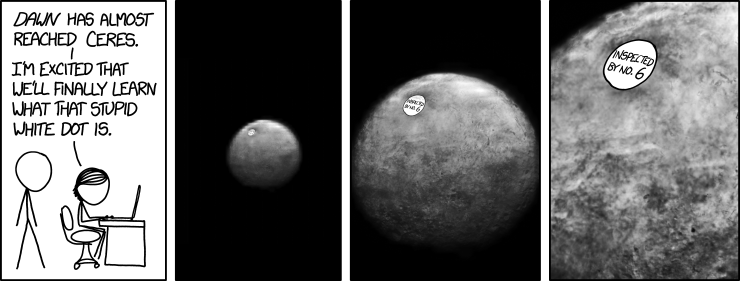Between the orbits of Mars and Jupiter spins an asteroid belt, and in that asteroid belt is the inner solar system's dwarf planet. Ceres makes up a third of the asteroid belt's mass, and, with a diameter of 950 kilometres (590 miles), it was originally thought to have been a planet on its discovery in 1801.
Now, astronomers believe that Ceres is a protoplanet. A protoplanet is a planetary embryo, formed inside a star's protoplanetary disc during the creation of the solar system. It has a differentiated interior produced by internal melting, but that isn't big enough to be given full planet status.
NASA believes that studying Ceres -- about which relatively little is known, compared to the rest of the solar system -- will provide vital information about the formation of our own solar system.
ceres2.gifDawn observed Ceres for an hour, capturing this animation. NASA/JPL-Caltech/UCLA/MPS/DLR/IDA/PSI
This is the goal of the Dawn probe, launched in 2007 to study the two largest objects in the asteroid belt -- the protoplanet Vesta (with a diameter of 525 kilometres, or 326 miles) and Ceres.
Dawn left Vesta's orbit on September 5, 2012, with over 30,000 images of the protoplanet under its belt, and is due to reach Ceres on March 6, 2015. As it approaches the dwarf planet, it will be snapping a series of better and better images for navigation purposes -- but they will also provide early clues about Ceres.
"We know so much about the solar system and yet so little about dwarf planet Ceres. Now, Dawn is ready to change that," said Dawn's chief engineer and mission director Marc Rayman.
The first of these images, coming in at a resolution of 27 pixels from a distance of 383,000 kilometres (238,000 miles) away, isn't quite as high quality as images snapped by the Hubble telescope in 2004 and 2005, but already it's providing hints about what NASA will find.
"The images hint at first surface structures such as craters," said Andreas Nathues, lead investigator for the framing camera team at the Max Planck Institute for Solar System Research, Gottingen, Germany.
As Dawn grows closer, the images should reveal more about what lies on -- and beneath -- Ceres' surface. The little evidence gathered to date suggests that it may have frost on its surface, and an ice layer beneath a thin, dusty crust. Stay tuned to the Dawn mission website for updates.








Comment